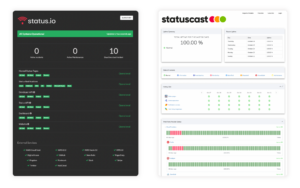In the modern day IT landscape, service reliability is of the utmost importance. Status pages serve as crucial interfaces, communicating any interruptions or issues to stakeholders. While several options are available, two notable status page providers stand out: StatusCast and Status.Io. Here we take a dive into the various aspects of status pages and incident management for each status page service.

StatusCast vs Status.Io Features
Status Page Types
Status.io and StatusCast both offer Public and Private Status Pages. However, while Status.io is positioned to provide for small to mid market customers who need a basic status page to report on a simple IT infrastructure, StatusCast is built to meet the needs of enterprises. Thereby providing a best-in-class private status page built for effective internal incident communication for large organizations managing a myriad of complex systems and organizational structure. StatusCast goes beyond a simple dashboard to monitor downtime, to a scalpel that cuts to the heart of downtime costs, reducing employee productivity loss and empowering IT to expedite incident resolution. StatusCast’s first class experience goes a step further, with Audience Specific Pages, which are custom status page views for end users based on their roles or needs, providing updates and visibility only about components and services that affect them.
Incident Management and Reporting
While the status page is Status.io's only product line, StatusCast also offers an end to end Incident Management suite that IT departments can leverage to coordinate efforts and manage processes to accelerate incident resolution. StatusCast’s Incident Management solution can be utilized as a stand alone, or combined with any status page. Their incident management offers many cutting edge features that equip IT to manage downtime effectively, including its Root Cause Analysis (RCA) Reporting, allowing teams to not just respond but to proactively understand and address the origins of disruptions before they occur. Their incident management service also provides intelligent escalations, automating incident response by notifying the right people. The pairing of incident management software combined with a status pages ensures that incidents aren't just effectively communicated, but are proactively managed with enhanced foresight and efficiency.
Subscriber Controls
Both StatusCast and Status.Io offer extensive subscriber notifications. However, StatusCast elevates the personalized experience for subscribers to a new level with the enhanced segmentation of their audience-specific status pages, delivering tailored notifications about relevant component or service statuses. By only delivering information pertinent to each subscriber, StatusCast effectively eliminates unnecessary noise and alert fatigue.
Third-Party Status Page Integrations
Status.io and StatusCast both provide third-party status page integrations, but StatusCast offers many of these integrations out of the box. Where StatusCast truly differentiates itself is in the granularity of its integrations. With StatusCast, users can selectively integrate specific components or services from third-party pages. This ensures that businesses present only the most relevant information to their users, ensuring a streamlined experience. This level of detail and precision, paired with out-of-the-box availability, sets StatusCast ahead with regard to third-party status page integrations.
Status page customization
While both Status.io and StatusCast support the fine-tuning abilities provided by custom CSS, StatusCast goes a step further in supporting a tailor made status page experience. StatusCast provides an intuitive drag-and-drop status page builder enabling those with limited technical expertise, or with limited time, to craft and mold their status page to meet the standards of their brand design and user experience. When it comes to status page notifications, StatusCast’s customizable email templates communicate brand trust that end-users expect. From the website to the inbox, the message remains consistently 'yours'. StatusCast also enables custom content like widgets or buttons, provides over 20 widgets with granular controls over their data and visibility, and supports single or multi-column layouts.
Status Page Pricing
While Status.io positions itself as a provider for small to mid market buyers who need a basic status page solution, StatusCast's SMB plan for 2,000 status page subscribers actually comes in at a lower price point than Status.io's Standard plan offering the same number of subscribers. StatusCast’s ITSM services are built for enterprises, but with competitive pricing that scales relative to the needs of customers of any size.
Status Page Performance
The reliability and responsiveness of a status page are paramount, as the status page is the the first line of defense during IT failures. When evaluating performance, key metrics to consider include uptime, latency, and the agility of alert notifications. Both StatusCast and Status.io consistently deliver in these areas, ensuring reliable performance of their status page functionality during critical incidents.
User Friendliness
Both StatusCast and Status.io excel in user-friendliness, setting them apart from other status page services. Their easy setup and intuitive configuration streamline the onboarding process. StatusCast's dashboard is designed with the convenience of set-up in mind, providing full control over the selection and drag-and-drop functionality of various types of widgets. Both platforms offer support, but StatusCast’s extensive online guides in their knowledgebase go further to give users in-depth information, ensuring they get the most out of the platform.
Incident Management Features
StatusCast stands apart as a holistic solution, offering not only status page software but also an all-encompassing incident management suite. This proves to be the starkest contrast between Status.io and StatusCast, as Status.io only provides a status page. What sets StatusCast's incident management solution apart from others is its unique position to leverage a status page that prioritizes stakeholder communication and takes an asset first approach to managing incidents. This strategic design empowers businesses to effectively diminish the economic impact of service outages. The emphasis on reducing mean time to resolution (MTTR) and minimizing employee productivity loss makes it uniquely positioned to significantly reduce the cost of downtime.
StatusCast’s Incident Management Features Include:
- Intelligent Escalations
- Intuitive Workspace Collaboration
- Effective Task Management
- Extensive Integrations with Critical Third-Party ITSM Tools
- Comprehensive Reporting & Root Cause Analysis
- Manage Incidents from Within Slack & Teams
- Teams and Shifts
- Metric Collection and Publishing
- End User Incident Reporting
Reputation: Comparing Reviews
In the quest for a reliable status page provider, a vendor's reputation stands as a testament to their capability in staving off IT failures that cascade into immense financial and reputational costs. StatusCast maintains some of the highest ratings of any status page service on platforms like G2 (4.8/5) and Capterra (4.8/5), whereas any reviews for Status.io are difficult to find.
How to Decide What Status Page is Best for You?
While both platforms have their merits, your choice will hinge on your specific needs. If you value a robust solution to incident communication, with superior integrations and customization, and comprehensive incident management, that is trusted by some of the largest Fortune 100 enterprises, then StatusCast is the obvious choice. However, for businesses on a tighter budget who are looking for a basic solution, Status.Io might suffice.
FAQs
What's the Difference Between StatusCast and Status.Io?
StatusCast offers 3 status page types based on the specific needs of the customer, while Status.io only offers 2. Also, StatusCast offers an entire incident management product that Status.io does not.
Which Status Page is More Reliable?
Both aim for high reliability, but StatusCast's advanced monitoring offers quick notifications during interruptions. StatusCast has been a profitable and self-funded company, trusted by some of the world's largest enterprises across healthcare, telecommunications and SaaS since 2013.
What Factors to Consider When Comparing Different Status Pages?
Someone in the market for a status page solution should consider: reputation and longevity, proactive multi-channel notifications, status page types, customization, integration capabilities, incident management features, and pricing.
StatusCast is the entire package for enterprise businesses to proactively manage incidents, reduce lost employee productivity during outages and mitigate the cost of downtime by keeping your employees and your customers informed during service outages.







